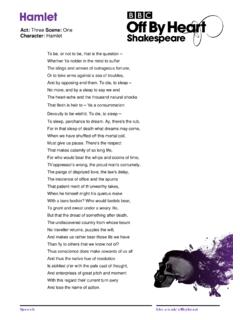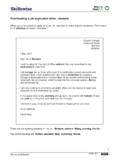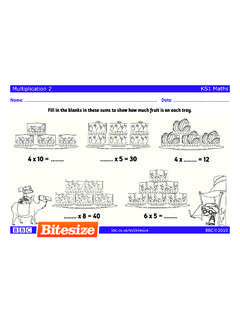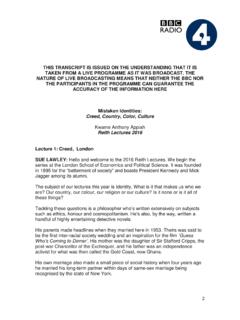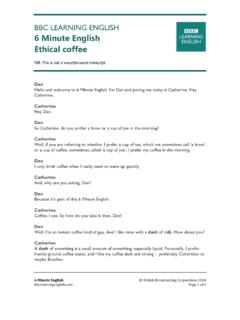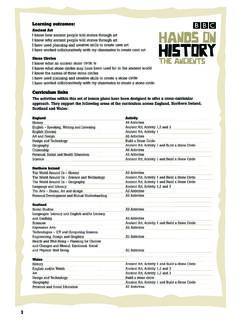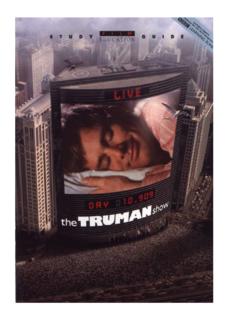Transcription of 1930s
1 1930s The first purpose-built broadcast centre in UK In 1932 the BBC left Savoy Hill, its first headquarters, for Broadcasting House in Portland Place. This impressive art deco building quickly became a London landmark and was described as a new Tower of London . Its shape was even compared to a luxury liner and today it is a listed building. It was innovative, not only in its unique design, but also its technical infrastructure and services. However, broadcasting developed so exponentially during this period that within a few years the building was far too small for its vastly expanded work force. Expansion of services Broadcasts in the Thirties covered a wide area from news, talks and plays to music, sport andchildren s programmes. The BBC had already become a major patron of the arts, commissioning music and drama.
2 Gustav Holst was the first composer commissioned by the BBC. His The Morning of the Year was completed in 1927, the year when the BBC broadcast its first Promenade Concert. Henry Wood inaugurated the Proms in 1895 and the BBC took them over when they ran into financial BBC Symphony Orchestra was also established and first broadcast under Dr Adrian Boult in 1930. Education was an important priority for Reith and school broadcasts were heard in over 8,000 schools by the late Thirties. Outside broadcasts covered sports ranging from football and cricket to rugby and the Boat Race. Variety, as light entertainment was called, had millions of listeners. Band Waggon with Arthur Askey and Richard Murdoch and ITMA (It s that Man Again) with Tommy Handley had a huge following, but good taste and decency became an issue early on for the BBC.
3 Comedians overstepped the mark at their peril and detailed guidelines were given to artists and producers to ensure that there were no jokes about religion, drunkenness and many other sensitive subjects. I speak now from my home and from my heart to you all; to men and women so cut off by the snows, the desert, or the sea, that only voices out of the air can reach them. King George V, first royal broadcast to the British nation and Empire In 1932 the BBC broadened its horizons with the opening of the Empire Service, the forerunner of BBC World Service. The first foreign-language service was Arabic, introduced in 1938. On the eve of the Second World War, the BBC launched services to Europe in French, German, Italian, Portuguese, Spanish and English. On Christmas Day 1932, King George V gave the first broadcast to the Empire by any monarch.
4 It was scripted by the famous author Rudyard Kipling. The world s first regular TV service John Logie Baird had given the first public demonstration of low-definition television back in 1925. There had been experimental transmissions from a studio in Broadcasting House since 1932. On 2 November 1936 the BBC opened the world s first regular service of high-definition television from Alexandra Palace in North London, known affectionately as Ally Pally . Not many people could pick up the "flickering" rays of the first programmes on their 10-inch televisions. The transmissions reached only the 20,000 homes with a television within a 35-mile range of Alexandra Palace. The first sets cost about 100, the same price as a small car. Sir John Reith, who was to resign from the BBC in 1938, had little enthusiasm for the new medium.
5 "To Alexandra Palace for the television opening," he noted in his diary, "I had declined to be 1televised or take part .." Later he described television as "an awful snare". Broadcast firsts Like radio, the world s first regular high- definition television service developed rapidly between 1936 and 1939. An impressive number of Outside Broadcasts were made. Viewers were able to watch King George VI s Coronation Procession (May 12, 1937), see Wimbledon (June 1937) and the FA Cup Final (April 30, 1938). But these broadcasts were only possible from places near London and when there were sufficient resources. When the 1938 Boat Race was televised, only the finish could be shown. For most of the race viewers saw the Alexandra Palace announcer moving models along a model of the course. But viewers were able to watch a wide variety of programmes, including plays, newsreels, concerts, opera, ballet, cabaret and children s cartoons.
6 Leslie Mitchell, Jasmine Bligh and Elizabeth Cowell were the first three BBC Television service presenters. It was said that the cameramen would put gauze over their camera lenses to soften the beautiful Miss Bligh s looks if she had been to a party the previous night. Pre-war television actors were paid less than their radio counterparts. One argument for this was that radio had a bigger audience and that television only showed the actors in miniature. On September 30, 1938 Richard Dimbleby, father of David and Jonathan, was at Heston Airport to report for both radio and television on Prime Minister Neville Chamberlain's return after his historic Munich meeting with Hitler. On 1 September 1939, two days before war broke out, a Mickey Mouse cartoon was being shown when the television service was suddenly blacked out for defence reasons.
7 It was feared that the transmitters could have provided navigational aid for enemy aircraft. That same Mickey Mouse cartoon was shown on June 7 1946 when BBC television re-opened. The Victory Parade was televised the next day. 21930s Behind the Scenes SAVOY HILL CLOSES Despite the friendly atmosphere, the working conditions at Savoy Hill were not ideal. The studios were so heavily draped that acoustics were flat, ventilation non-existent and performers suffered in the heat. But the Savoy Hill programmes were now part of Britain s cultural life. When the studios closed, the BBC was ten years old and five million people held a listener s licence. BROADCASTING HOUSE OPENS The BBC considered sites in Trafalgar Square, the Haymarket and Park Lane. Portland Place w as chosen when the home of James Watt, the inventor, was demolished.
8 The 1933 yearbook says there are 800 doors in Broadcasting House - one for every person, more than one radiator per person, one clock to 8 persons and light bulbs per person. This art-deco liner , opened by John Reith is now a listed building (Grade II). OBITUARIES GUGLIELMO MARCONI (1874 - 1937) Engineer and Physicist Arrived in England from Italy in 1896. Developed wireless telegraphy and formed the Marconi Company. Awarded the Nobel Prize for work on radio signals. Helped to form the British Broadcasting Company in 1922. In 1937, his Emitron camera was adopted by the BBC s newly-established television service. On his death, wireless stations throughout the world closed down. For two minutes the airwaves were as quiet as they had been before Marconi. 31930s Technology THE BOAT RACE 1938 When the Oxford and Cambridge boat race was first televised, it was technically possible to show only the finish.
9 For most of the time, viewers watched the Alexandra Palace announcer moving models along a map of the course. But the high quality transmissions fired the public interest in television and the sale of sets began to rise. GEORGE VI CORONATION 1937 The procession was televised from Hyde Park Corner using three brand new Emitron cameras linked by cable to Alexandra Palace. It was a huge undertaking for the new television service and the relief that he'd got the right pictures showed on the cameraman's face. But this 'small miracle' as the Press called it, was seen on television by only 10,000 people. GOLF DEMONSTRATION 1937 This was the first test transmission of an Outside Broadcast. Archie Whitcomb demonstrated golf shots in the gardens of Alexandra Palace. Because Whitcomb's drive seems to have got lost somewhere in the ether, we will have to rely on the judgement of commentator Leslie Mitchell that it was 'a beauty'!
10 41930s Key dates 1930 9 March - Start of regional scheme offering alternative radio programmes. 14 July - First experimental television play, The Man with the Flower in His Mouth, transmitted. 22 October - First broadcast by the BBC Symphony Orchestra. 1931 27 July - First broadcast of BBC Theatre Orchestra. 18 December - First broadcast of BBC Chamber Orchestra. 1932 12 March - First broadcast from BBC Broadcasting House. 1 May - Broadcasting House in London officially opens after the Savoy Hill studios close. 19 June - First service broadcast from All Souls, Langham Place. 22 August - First experimental television broadcast from Broadcasting House. 19 December - Empire Service inaugurated on short-wave.
